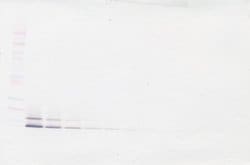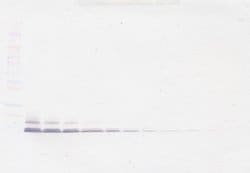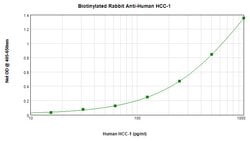Learn More
CCL14 Polyclonal Antibody, Biotin, PeproTech®, Invitrogen™
Rabbit Polyclonal Antibody
$2175.00
Specifications
| Antigen | CCL14 |
|---|---|
| Concentration | 0.1-1.0 mg/mL |
| Applications | ELISA, Western Blot |
| Classification | Polyclonal |
| Conjugate | Biotin |
| Catalog Number | Mfr. No. | Quantity | Price | Quantity & Availability | |||||
|---|---|---|---|---|---|---|---|---|---|
| Catalog Number | Mfr. No. | Quantity | Price | Quantity & Availability | |||||
50-271-8711

|
Invitrogen™
500P106BT500UG |
500 μg |
Each of 1 for $2,175.00
|
|
|||||
Description
AA Sequence of recombinant protein: TESSSRGPYH PSECCFTYTT YKIPRQRIMD YYETNSQCSK PGIVFITKRG HSVCTNPSDK WVQDYIKDMK EN. Preparation: Produced from sera of rabbits immunized with highly pure Recombinant Human HCC-1 (CCL14). Anti-Human HCC-1 (CCL14)-specific antibody was purified by affinity chromatography and then biotinylated. Sandwich ELISA: To detect Human HCC-1 (CCL14) by sandwich ELISA (using 100 μL/well antibody solution) a concentration of 0.25-1.0 μg/mL of this antibody is required. This biotinylated polyclonal antibody, in conjunction with PeproTech Polyclonal Anti-Human HCC-1 (CCL14) (500-P106) as a capture antibody, allows the detection of at least 0.2-0.4 ng/well of Recombinant Human HCC-1 (CCL14). Western Blot: To detect hHCC-1 by Western Blot analysis this antibody can be used at a concentration of 0.1-0.2 μg/mL. Used in conjunction with compatible secondary reagents the detection limit for Recombinant hHCC-1 is 1.5-3.0 ng/lane, under either reducing or non-reducing conditions. 500-P106BT-1MG will be provided as 2 x 500 μg
This gene, CCL14, is one of several CC cytokine genes clustered on 17q11.2. The CC cytokines are secreted proteins characterized by two adjacent cysteines. The cytokine encoded by this gene induces changes in intracellular calcium concentration and enzyme release in monocytes. This gene expresses both monocistronic and bicistronic transcripts. Bicistronic transcripts include the upstream cytokine gene CCL15. In addition, CCL14 undergoes alternative splicing in the bicistronic transcripts; it is unknown if its monocistronic transcript is also subject to alternative splicing.Specifications
| CCL14 | |
| ELISA, Western Blot | |
| Biotin | |
| Rabbit | |
| Human | |
| Q16627 | |
| 6358 | |
| E.coli-derived Recombinant Human HCC-1 (CCL14) (72 a.a.). | |
| Antigen affinity chromatography | |
| CCL14 |
| 0.1-1.0 mg/mL | |
| Polyclonal | |
| Lyophilized | |
| RUO | |
| PBS with no preservative | |
| C-C motif chemokine 14; C-C motif chemokine ligand 14; CC-1; CC-3; CCL14; chemokine (C-C motif) ligand 14; chemokine CC-1/CC-3; chemokine CC-3; CKB1; H HCC-1(1-74); HCC-1; HCC-1(1-74); HCC-1(3-74); HCC-1(4-74); HCC-1(9-74); HCC-1/HCC-3; HCC-3; hemofiltrate CC chemokine 1; MCIF; NCC2; NCC-2; new CC chemokine 2; SCYA14; SCYL2; small inducible cytokine subfamily A (Cys-Cys), member 14; small-inducible cytokine A14; SY14 | |
| CCL14 | |
| Primary | |
| -20°C |
The Fisher Scientific Encompass Program offers items which are not part of our distribution portfolio. These products typically do not have pictures or detailed descriptions. However, we are committed to improving your shopping experience. Please use the form below to provide feedback related to the content on this product.


